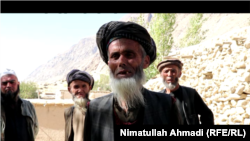WARDUJ, Afghanistan -- Residents say fear lingers in a remote Afghan district after government forces ended years of Taliban rule there by forcing the insurgents out in a fierce battle last month.
Life is slowly returning to normal in Warduj. Displaced residents and officials have returned to this mountainous district in the remote northeastern province of Badakhshan, which borders Tajikistan, China, and Pakistan.
Qiamuddin Fayeq, 53, is among the Warduj residents who endured nearly four years of Taliban rule after the insurgents overran the district in October 2015. He lives in his mud hut along with his wife and their three daughters and four sons.
“Our homes were destroyed by bombs and artillery fired by the government and by the Taliban,” Fayeq told Radio Free Afghanistan.
He says that while security has improved, the fear of a Taliban comeback haunts them.
“If the government doesn't pay attention, the Taliban will return,” he noted. “If our schools remain shut, our children will be illiterate and become a burden on society.”
Fayed has no job and makes ends meet by occasionally selling sheep from his flock. “We have nothing but a few mattresses. We only have some thin quilts that offer little protection against the harsh winter,” he said.
He says he is deeply disappointed by lack of support offered by the government since he returned home after briefly fleeing the fighting in September.
“We were among the 30 to 40 families who fled the district on our bare feet,” he recalled. “The former district governor gave us a bag of flour, a bag of rice, a bit of oil, and some tea. But we have received no help since then.”
Mohammad Tahir, an elderly farmer, also stayed back in Warduj during the Taliban rule. Tahir recollects that the insurgents used to force locals to feed them and carry water, equipment, and weapons to their hideouts in the remote mountains.
Tahir enjoys the relative tranquility in Warduj but is fearful that
if the Taliban return, they would “decapitate” everyone who has worked with the government or supported the authorities.
“Life is not good. We ask the government to help us. We have been in misery for four years. We have not received any help,” he said, urging the government to act swiftly to stabilize their lives and improve conditions in Warduj.
Harking back to the hard-line group’s harsh rule in the 1990s, the Taliban control in Warduj appeared to be a concerted effort to recreate a mini Taliban state obsessed with controlling the region’s residents.
“After capturing the region, they first collected all television sets to enforce a ban on watching it, and they banned women from going to the local bazaar without a male guardian,” Mohammad Dawlat Khawar, a former district governor of Warduj, told RFE/RL’s Gandhara website in 2018.
Apart from the moral policing, the hard-line Islamist militia also deprived Warduj residents of key services and development.
Dawlat Mohammad is a 57-year-old resident of Chakran, the district center of Warduj. He says Warduj was stripped of all reconstruction programs during the Taliban’s rule.
“During the four years of Taliban rule, we lagged behind 30 years,” he added.
Mohammad says crumbling school buildings force students to study under the shade of trees and the hospital in Warduj has no medicine. The district has 15 schools, including two high schools for boys and three for girls. But during most of the Taliban’s rule, girls were not allowed to attend school. They also barred women from the only teachers’ training college in Warduj.
District Governor Mohammad Imran Payam is the government’s point man in ensuring that Warduj remains under Kabul’s control.
He says the Taliban oppressed residents and destroyed or damaged government offices in the region by vandalizing doors and windows and burning furniture.
“Our district has seen four years of poverty, homelessness, and displacement. It still has many problems,” he said. “We are currently building a local [government] office. There are construction issues and other problems that cannot be dealt with at once.”
He wants more security forces to deal with the challenges ahead. Payam says that Taliban militants, along with a few hundred foreign fighters, mainly from Central Asian countries, are still active and holed up in remote villages of Bashund, Sofian, and Teergeran.
“We are concerned about improved coordination and greater effectiveness of the air and ground forces [to keep the Taliban away],” he said.
Just recently, the head of Badakhshan’s provincial council, Ahmed Bashir Samim, told Radio Free Afghanistan that at least 10 civilians were killed and wounded during an Afghan air operation in the Bashund area.
But Fawad Aman, deputy spokesman for the Defense Ministry, said the civilians were killed and wounded when a rocket fired by the Taliban hit them.












